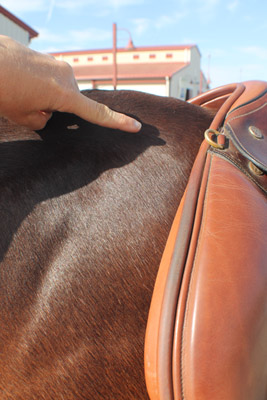 There’s nothing like purchasing a new pair of boots. Chances are they were a very significant investment and were made by a reputable company. You’re proud to show them off, but no matter how hard you try to break them in, there is still one spot that pinches your toe, rubs your ankle or squeezes your calf. And when you wear them, that is ALL you can think about. If a pair of boots can leave you feeling sore, imagine how your horse feels after wearing an improperly fitted hunt seat saddle. Regardless of how expensive the saddle or which company built it, if it doesn’t fit correctly, your horse will notice.
There’s nothing like purchasing a new pair of boots. Chances are they were a very significant investment and were made by a reputable company. You’re proud to show them off, but no matter how hard you try to break them in, there is still one spot that pinches your toe, rubs your ankle or squeezes your calf. And when you wear them, that is ALL you can think about. If a pair of boots can leave you feeling sore, imagine how your horse feels after wearing an improperly fitted hunt seat saddle. Regardless of how expensive the saddle or which company built it, if it doesn’t fit correctly, your horse will notice.
“The main reason for the proper fitting of a saddle is for the horse’s comfort. The horse cannot perform well if the saddle is causing pain,” says Mark Walter, president of Beval Saddlery.
Chances are open riders and trainers riding multiple horses cannot purchase a custom saddle for every horse they ride. Fortunately, many saddles fit a variety of horses. “Saddles are so well made today that they seem to melt to the horses once they are broken in,” says AQHA Professional Horsewoman and Judge Chris Thompson,of Aiken, South Carolina.
And, “riders/trainers tend to go towards similar style horses,” Walter adds, “if the horses are built similarly, they can use the same saddle as long as the horse is comfortable.” Although many horses are fairly easy to fit with basic tree designs, there are some that are much more suited to more specific tree and panel designs.
 Horses with high withers and low backs or extremely wide backs make saddle fit challenging.
Horses with high withers and low backs or extremely wide backs make saddle fit challenging.
“I find the really, really wide backed horses are the most difficult to fit,” says Deanna Searles of Circle S Ranch in Scottsdale, Arizona. To avoid saddle fit issues, “I personally don’t ride hunt seat on Halter horses,” she says.
A saddle with a narrow tree and gullet placed on a wide-backed horse rocks from side to side or rolls from front to back.
“When you set a saddle on the back of a super wide horse it tends to teeter-totter,” Walter explains. Even, if the saddle appears to be properly balanced, the panel should be checked for uniform contact and pressure. Tight spots in the panel can also indicate a tree is too narrow.
High-withered horses are equally challenging to fit. A saddle with panels that match the angle of the horse’s anatomy will keep the saddle off the horse’s withers.
“The angle of the tree should be within 10 percent of the horse’s angle behind the scapula,” Walter explains. Contoured pads or cut-back pads are designed to alleviate discomfort for horses with high withers.
Bridging is also a common challenge in fitting a hunt seat saddle. Bridging occurs when the saddle makes contact at the wither/shoulder area and at the cantle, but little or no contact at the wither/shoulder area and at the cantle, but little or no contact with the horse’s back in that area, and usually indicates that the tree is too narrow or the panels are too thin. Sometimes, the correction can be as simple as adding additional foam or wool flocking to the panel. Other times, the horse will need a saddle with a different size tree.
Many riders make small adjustments with half pads, risers and gel pads, or even double pads to alleviate pressure on a horse’s back.
“The use of pads can help, but it is best to fit the horse correctly,” Walter says, “I don’t advocate fixing a fit problem with pads, but it can help in certain situations.”

Fitting the rider
Fitting a saddle to the horse is only half the equation. The saddle must also be comfortable for the rider.
“You can get the fit right for a horse, but if the saddle isn’t right for the rider’s balance, it all goes downhill,” Walter says.
A rider in a saddle that is too small has the tendency to tip forward in the seat to maintain balance. Similarly, a saddle that is too large forces a rider to work hard to maintain balance in the seat shifting their focus away from the horse.
“As a general rule, while sitting in an English saddle, a rider should be able to place her hand behind her in the saddle before reaching the back of the cantle,” explains Allison Parker of Allison Parker Performance Horses in Greensboro, North Carolina.
Typically, a 16 inch seat works well for youth and petite adults with 17 inches being the most common size for adults. “The 17 inch seat sounds big- it’s really not- it’s more standard for adults,” Thompson says.
A properly fitted saddle encompasses more than the seat. The flap length is also very important.
 “The rider’s knee should hit at the top point of the flap with an inch to two inches to spare,” Parker says. “This is the area I have seen most riders have the greatest discomfort, to the point of getting sores on the inside of the knee.”
“The rider’s knee should hit at the top point of the flap with an inch to two inches to spare,” Parker says. “This is the area I have seen most riders have the greatest discomfort, to the point of getting sores on the inside of the knee.”
Additionally, the length of the flap should hit far enough down the calf so the top of the boot does not interfere with the bottom of the flap.
Stirrup leathers are also known to bother riders. “Stirrup leathers that bulge out, either because the leather is too thick or the buckles on the straps are too big rub on a rider’s thighs and cause bruises,” Searles says.
Depending on the saddle’s construction, the correction can be as simple as switching the offending stirrup leathers out for ones that are not as thick or those with smaller buckles. However, “if it’s the way the saddle is made, then the rider will need to get a different one (saddle),” she adds.
Ask for help
Fortunately, for Hunt Seat riders, English saddles do not go in and out of fashion like Western saddles do.
“If you get a good quality saddle, it will last a really long time,” Thompson says, “depending on budget, look at used saddles too, an added benefit is that they’re already broken in.”
Visit a local saddle shop and sit in several different saddles to find a seat that is comfortable. Some may even let you haul your horse over for a test ride. If you ride at a large barn take advantage of the variety of saddles on-site. Ask other riders if you can sit in their saddle for a test ride.
“Everyone is different in her likes and dislikes in English saddles. Before choosing which saddle to purchase, I suggest riding in as many different saddles as you can. Make sure you find one you feel secure in,” Parker adds.
Finding a saddle that fits the horse and rider can be challenging.
“Ask a professional horseman for their opinion on different saddles,” Thompson suggests, “It might help you make a decision.”



You must be logged in to post a comment Login